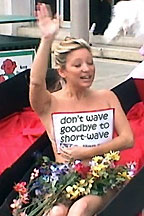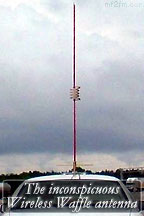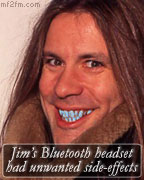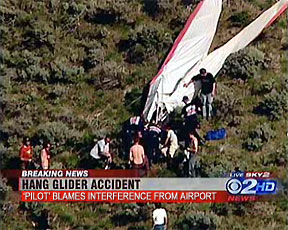Tuesday 28 April, 2009, 07:22 - Radio Randomness
Posted by Administrator
Posted by Administrator
 The threat to short-wave reception caused by PLT (a.k.a. BPL) devices is something that has been covered on Wireless Waffle on numerous previous occasions.
The threat to short-wave reception caused by PLT (a.k.a. BPL) devices is something that has been covered on Wireless Waffle on numerous previous occasions.Whilst it hasn't reached the point of naked protestors parading along the streets of London just yet, a while ago the technical group trying to curb the spread of these devices petitioned the UK Government to do something about it. The Government's response was rather lacklustre:
As with all electrical and electronic products sold in the UK, Power Line Technology (PLT) equipment is required to meet the relevant regulations before it can be placed on the market. In particular, it must comply with the Electromagnetic Compatibility Regulations 2006 (the EMC Regulations) ... and any person who places such products on the market ... must ensure that the products comply and apply the ‘CE’ mark.
The Department for Business Enterprise and Regulatory Reform (BERR) is responsible for the EMC Regulations. Enforcement powers are delegated to local Trading Standards offices, and to Ofcom where there is a radio spectrum protection or management issue. Ofcom estimates there are around 500,000 pieces of PLT equipment in use in the UK. Ofcom have received around 84 individual complaints of interference attributed to PLT equipment. All of these complaints are in the process of being investigated or have been successfully resolved. Each complaint is investigated on its own merits. We do not believe an outright ban of all powerline adaptors is justified.
A lot of buck-passing with the end result that nothing happened. But not to let a roaring lion lie, the good people at UKQRM have submitted a second petition:
We the undersigned petition the Prime Minister to require the relevant regulatory authority namely Ofcom to take active and speedy measures to test samples of all makes and types of PLT device and to remove from the UK market all those devices where the sample is found to be non compliant with the requirements of the Electromagnetic Compatibility Regulations 2006. And to take all practicable and necessary steps to prevent anyone placing non compliant PLT devices on the UK market now and in the future.
Wireless Waffle believes that the spread of PLT devices is something which needs to be checked and that the more cage rattling that is done, the better the chances of some real action being taken.
If you are a UK radio user, listener or someone who depends upon the radio spectrum for your profession or livelihood in the UK, whether you are interested in short-wave or not, we would urge you to sign the petition. The slow march of PLT devices represents what will no doubt be the first of many attacks on the precious raw material which underpins so many UK jobs and with the credit crunch already hitting people's employment, anything which protects future generations has to be good.
Please go and sign the petition at http://petitions.number10.gov.uk/SaveShortwave2/ and add your name and voice to ensure that future voices will be able to hear each other!
Let nation (be able to continue to) speak peace unto nation... as someone once said.
add comment
( 1906 views )
| permalink
| 



 ( 3 / 28668 )
( 3 / 28668 )




 ( 3 / 28668 )
( 3 / 28668 )
Wednesday 1 April, 2009, 05:30 - Radio Randomness
Posted by Administrator
For some time, there has been software available on the internet which would allow anyone with enough brains and patience to hack into a 'WEP' encrypted WiFi link. 'WPA' encrypted links are more secure but even they are open to hacking. The basic problem with such devices is that they transmit the data freely across the ether and if a miscreant within range has the right equipment and software they can intercept the radio signal and decode it. Be sure though that it takes a lot of effort, someone would really have to be serious in order to bother having a go at WPA and WPA2.Posted by Administrator
 But regardless of the encryption technology used, the key problem with any WiFi network is that the signal is purposefully transmitted over a wide area. Obviously running a direct wired connection between two points is much more secure. Surprise, therefore, may be expressed at the realisation that even the radiation from computer keyboards can be sufficient to allow 'snooping' on your computing activities from a distance.
But regardless of the encryption technology used, the key problem with any WiFi network is that the signal is purposefully transmitted over a wide area. Obviously running a direct wired connection between two points is much more secure. Surprise, therefore, may be expressed at the realisation that even the radiation from computer keyboards can be sufficient to allow 'snooping' on your computing activities from a distance. Two Swiss scientists have proven that this can be done, even through a wall, despite the fact that the levels of radiation coming from the keyboard are very small indeed.
But what about the new PLT (power line telecoms) or BPL (broadband over power line) technologies. These devices send your precious data over electrical cables which, any number of studies have shown, leak the signal hither and thither, causing both radio interference over a wide area and opening up the opportunity for someone to intercept the signal.
Some PLT/BPL devices have been received at over 500 metres from the building in which they are installed, which is, in most cases, further away than it would be possible to receive an equivalent WiFi signal. Wireless Waffle therefore decided to follow in the footsteps of the hitherto mentioned Swiss scientists and see whether or not it was possible to intercept and decode emissions from these devices in order to try and ascertain how secure they are or aren't.
 The devices which seem to send out the greatest signal are those manufactured by a company called Comtrend, and which use the chipset from another company, DS2. The first thing to do, therefore, was to get hold of a Comtrend device and modify the circuitry to make a seperate antenna input rather than the device looking for the signal on the mains cable to which it is attached.
The devices which seem to send out the greatest signal are those manufactured by a company called Comtrend, and which use the chipset from another company, DS2. The first thing to do, therefore, was to get hold of a Comtrend device and modify the circuitry to make a seperate antenna input rather than the device looking for the signal on the mains cable to which it is attached.A suitable Comtrend device was purchased from the web's best know outlet of all things slightly dodgy which was then dismantled to see where the signal input is. It turns out that the device sniffs the signal from the mains through a couple of high voltage capacitors. It is a straightforward job, therefore, to lift these capacitors from the circuit board and attach an alternative signal feed.
Making a wideband antenna capable of receiving the whole HF frequency range (2 - 28 MHz) used by these devices is not necessarily straightforward, however a short whip (1m or so long) connected directly to the input of a high-impedance FET amplifier does a pretty good job and whilst the response isn't necessarily flat across the HF range it does a reasonable job of receiving something at all frequencies. And, let's face it, the frequency response of the mains cabling to which the devices are normally connected is not flat either so a bit of loss here and there shouldn't be anything to worry about.
So, armed with an inverter (to provide the Comtrend device with 240V from the DC power outlet in a car which was felt easier than supplying it with the various DC voltages it needed), a laptop with which to connect to the modified device and a whip antenna, the intrepid Wireless Waffle team set off to see whether or not it is possible to intercept data being sent over electrical mains wiring and thereby spy on local internet activity.
The first test was to set up a couple of devices in a known configuration and then put the 'interception' kit inside the house in which the devices were installed. This gives the set-up the maximum possible chance of receiving the data as the signal received on the antenna within the house as pretty much as strong as it is on the mains wiring itself!
Not surprisingly, in such an 'ideal' test set-up it was a piece of cake to read the data passing over the mains cabling.
 Next, the interceptor was moved to a car parked outside the house with a suitably covert antenna placed secretly on the roof. Again, it was easy to receive and read the data being sent over the mains cabling. If it were me using these devices in my house, this is the point that I would begin to realise that the devices are not even as secure as WiFi, and would get rather nervous. The car was then driven 100 metres away from the house under test whilst keeping the system turned-on. At this distance, the signal from the house had fallen significantly (though was still perfectly audible on a test receiver).
Next, the interceptor was moved to a car parked outside the house with a suitably covert antenna placed secretly on the roof. Again, it was easy to receive and read the data being sent over the mains cabling. If it were me using these devices in my house, this is the point that I would begin to realise that the devices are not even as secure as WiFi, and would get rather nervous. The car was then driven 100 metres away from the house under test whilst keeping the system turned-on. At this distance, the signal from the house had fallen significantly (though was still perfectly audible on a test receiver).  At this distance, the simple interceptor spy-tool-device struggled to read the signal, however with some judicious placing of the receiving aerial, some of the data could be read. With such a simple set-up, not a great deal was really expected, however the tests proved PLT/BPL devices to be significantly less secure than WiFi being easy to intercept at distances of up to 100 metres from a house in which they are installed using very simple equipment.
At this distance, the simple interceptor spy-tool-device struggled to read the signal, however with some judicious placing of the receiving aerial, some of the data could be read. With such a simple set-up, not a great deal was really expected, however the tests proved PLT/BPL devices to be significantly less secure than WiFi being easy to intercept at distances of up to 100 metres from a house in which they are installed using very simple equipment. Unlike WiFi, however, it is not as easy to make a 2-way connection: whilst intercepting or spying on data is possible, completely hacking the connection and being able to use it, for example to connect to the internet or into a home network, is much more difficult. Generating enough transmitter power to put a strong signal on the internal mains wiring from 100 metres away would be no mean feat. That doesn't mean that it's not worth trying though...
Thursday 28 August, 2008, 17:12 - Radio Randomness
Posted by Administrator
Like all radio systems, wireless LANs can never be 100% reliable. Many factors affect radio transmission and even in situations where something might be expected to work well, problems can often occur. Wireless LANs suffer from a number of particular problems, not least the frequencies they use (around 2.4 GHz) are easily absorbed and reflected and can suffer from high levels of interference. But with a little care, their coverage and the reliability of the connection can be improved quite easily. Here are the Wireless Waffle top 5 tips for improving WiFi signals.Posted by Administrator
1. Choose the right channel
Interference from other wireless LANS is the most common cause of network quality degradation. The various surveys that Wireless Waffle has conducted have generally shown that channels 1 and 13 are the least likely to suffer from interference from other wireless LANs. Further, channels 10 upwards are the least likely to suffer interference from other users of the 2.4 GHz band. So generally speaking, in an area with a low likelihood of finding other WiFi users, channels 11, 12 or 13 are likely to be best. In congested areas (i.e. where interference from other WiFi systems is likely to be worse than from other users in the band), channel 1 is the best choice.
2. Position your WiFi hub centrally
Radio coverage from most transmitters radiates in all directions from the point of the transmitter, and this is certainly the case for wireless LAN equipment. It therefore makes total sense to position your central WiFi hub as close as possible to the middle of the area you wish to cover. Further, radio signals travel best if there is a clear path between both ends of the link. If you put the central unit in a cupboard or behind a bookshelf, where the path is already obstructed, coverage will reduce. Place the unit in an place with a clear view of the area you wish to cover, the higher the better (look at hubs installed in public places such as coffee shops and hotels - they are almost always mounted on the roof!)
 3. Keep your wireless equipment away from other wireless equipment
3. Keep your wireless equipment away from other wireless equipmentThere are many other sources of radio signals in the typical home or office environment and many of these are on frequencies similar to (or even the same as) WiFi. Placing these other radio sources near to wireless LAN equipment can result in reduced performance from the LAN as it struggles to cope with the interference caused by the other equipment. It's especially important to make sure that equipment such as digital cordless phones, satellite TV downleads, bluetooth and zigbee devices, mobile phones and digital baby alarms are not used in close proximity to a wireless LAN if service quality is not to suffer.
 4. Use equipment with proper aerials
4. Use equipment with proper aerialsDevices such as USB WiFi adapters are generally quite small and this means that the aerial inside them is also small. Smaller antennas pick up less signal and thus range and the quality of the connection will be adversely affected. If you are installing a wireless network for your home computer, use a proper PCI wireless card with an external antenna, rather than a USB wireless 'dongle'. This step alone can easily double or more the range you achieve from your wireless network and such cards are often cheaper than their dongle sidekicks.
5. Upgrade your antenna
It's easy to extend the range of a WiFi network by using higher gain antennas on hubs and on PC cards. Changing the antenna on the hub will affect all of the network, whereas changing it on a remote device will affect that device only. Most standard antennas have 2dB gain but 5, 7 or even 9 dB gain antennas can be purchased relatively cheaply. Changing from 2 to 7dB gain antennas will virtually double the range of your network. And if you replace the antennas on both the hub and the remote units with 7dB gain antennas, range will nearly quadruple.
Saturday 26 July, 2008, 16:01 - Radio Randomness
Posted by Administrator
Watching a number of hot air balloons float gracefully past recently, the question arose as to whether or not they used radio to communicate with the ground and, indeed, whether they used radios to communicate with air traffic controllers. A bit of digging around revealed that they do indeed carry aeronautical radios with them, and what's more they have a special 'balloon to ground' frequency. Not just that, but the same is also true of gliders, parachutists, microlights and hang- and para-gliders.Posted by Administrator
Below are all the commomn frequencies (in MHz) which are set aside, in the UK, exclusively for these special purposes, including a frequency set aside for fire services at airfields:
120.900, 130.100, 130.125 and 130.400 Gliders
129.975 Gliders (to mobile field units)
122.475 Hot Air Balloons
130.525 and 129.900 Parachutes
129.825 Microlights
118.675 Hang/Paragliders
121.600 Ground Fire Services
 The very observant amongst you may note that the frequency for Hang/Paragliders is just 25 kHz away from the Heathrow Airport (arrivals) tower frequency of 118.700 MHz. Typically, frequencies this close are not used in the same area so that any Hangglider flying near to Heathrow may cause disruption to the tower communications (and indeed the governing body for aero frequencies, ICAO, does not allow such clashes). The exceptionally observant amongst you will realise that if a hangglider got close enough to Heathrow airport to cause interference, it would have greater things to worry about than radio! So by simple spatial collision avoidance, interference is likewise stopped.
The very observant amongst you may note that the frequency for Hang/Paragliders is just 25 kHz away from the Heathrow Airport (arrivals) tower frequency of 118.700 MHz. Typically, frequencies this close are not used in the same area so that any Hangglider flying near to Heathrow may cause disruption to the tower communications (and indeed the governing body for aero frequencies, ICAO, does not allow such clashes). The exceptionally observant amongst you will realise that if a hangglider got close enough to Heathrow airport to cause interference, it would have greater things to worry about than radio! So by simple spatial collision avoidance, interference is likewise stopped.
